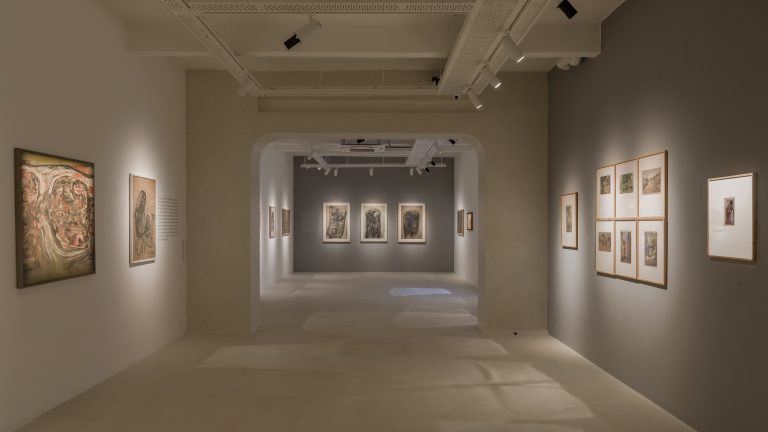![]() Tushar Joag, whose demise has elicited a soul searching whilst it may be temporary, that few others may inspire, since he propositioned for the self a kind of dissemination in art and society, conflating what is suspected to be mutually limiting, immiscible or even corrosive. For bringing art and activism together may read like an inter-caste marriage that makes many people uncomfortable. He wanted to test the limits of such ideas. And this did not stop at ideas without. With every new venture he kept challenging himself, expanding the ambitiousness of the enterprise. From incarcerating himself for a show titled, ‘Right to Dissent’ for which he preferred the term initiated over curated, to embarking on a motorcycle trip to China to reconnoitre across protesting strife-ridden locations. A route map was chartered, replete with and reviving an iconography of the romance of the ‘Motorcycle Diaries’ of Che Guevara. Acts such as these symptomatic of human endurance tests or feats, push physical limits and bring the body into the performance. A journeying in performance that might be traced to Bruce Nauman’s early works through to Matthew Barney’s series ‘Drawing Restraint’. Clearly, he meant to shape an elusive balance between art and conscience, ideological pursuits and its pitfalls. At a base level with astuteness and pragmatism if one may so generalise, he sought happiness for his home, self and society, and for whom I find the title ‘Yugpurush’ most befitting.
Tushar Joag, whose demise has elicited a soul searching whilst it may be temporary, that few others may inspire, since he propositioned for the self a kind of dissemination in art and society, conflating what is suspected to be mutually limiting, immiscible or even corrosive. For bringing art and activism together may read like an inter-caste marriage that makes many people uncomfortable. He wanted to test the limits of such ideas. And this did not stop at ideas without. With every new venture he kept challenging himself, expanding the ambitiousness of the enterprise. From incarcerating himself for a show titled, ‘Right to Dissent’ for which he preferred the term initiated over curated, to embarking on a motorcycle trip to China to reconnoitre across protesting strife-ridden locations. A route map was chartered, replete with and reviving an iconography of the romance of the ‘Motorcycle Diaries’ of Che Guevara. Acts such as these symptomatic of human endurance tests or feats, push physical limits and bring the body into the performance. A journeying in performance that might be traced to Bruce Nauman’s early works through to Matthew Barney’s series ‘Drawing Restraint’. Clearly, he meant to shape an elusive balance between art and conscience, ideological pursuits and its pitfalls. At a base level with astuteness and pragmatism if one may so generalise, he sought happiness for his home, self and society, and for whom I find the title ‘Yugpurush’ most befitting.

A shift took place in 1998, upon taking up a residency at the Rijks Academy. He was brought in contact with several writings, where he was distressed to learn that the many woes ailing the third world were stemming from first world policy of profiteering and capitalist greed. And later, to compound it, he surmised how even politically engaged practices sought affirmation of the white curator, institutions, big gallery representation towards the making of a top notch career and high billing of the incurring produce. He shut his studio during the open studio days, as an act of resistance destroying all his work. Returning back, he did not find appeasement with the world view he had formed; and he felt beleaguered in his outlook, and continued to destroy all his past work and associated documentation. He was seeking a new order and founded ‘Open Circle’, an artist initiative in Bombay, alongside spouse and artist Sharmila Samant, for which he also sought the support of Kausik Mukhopadhyay (with whom he had his first 2-person show), Mahua Ray, Archana Hande and Shilpa Gupta to complete an artist’s platform. This was within a year following the founding of KHOJ, International Artists’ Association in Delhi.
But his constant upheaval of his artistic self wouldn’t abate. The searching would aggravate it and the frequent disillusionment that followed meant that he would grapple and sometimes struggle with his faith. Finding meaning, virtue, currency each time is a constant churn. Some go more hard at it than others. He gravitated towards activism meanwhile and in time came out of the sabbatical, self-effacement and purging with a show titled ‘Reconciliation and Truth’, 2008. ‘The Enlightening Army of the Empire’, 2008 is a piece recalled most from this show where he had substituted circular lights for vital points and eyes, LED tubes for ribs to ascertain skeletal figures reminiscent of aliens from mainstream sci-fi cine cults like Star Wars and ET, doubling tubelights for lightsabres. The exploration of the language of cinema, its totems find some resonance and continuity in younger works even today. At least it immediately found recurrence in a Saatchi show with a tongue in cheek title, ‘Empire Strikes Back’, back in 2010.
In ‘Riding Rocinante’ and ‘Mumbai Wedding’ from a show titled ‘Land of Mine’ among others, we encounter processions, procession bands and marching, as a recurrent theme, not to mention pop slapstick humour and pantomime. A lot of the metaphors he resorted to in his art practice seem to belong to an urban dictionary. A childhood acculturation of superheroes comics, bikes, board games like monopoly that toy with wealth and capital was to spur some motifs in time. He would derive from popular culture; thus, the syntax of which he was familiar with and also not particularly averse to into art language even though his subjects of empathy were well out its bounds. If contemporary art was an urban phenomenon, then he had to conspire through its symbols, use them subversively, often in dystopian ways to strike at the hearts of sordid callousness and blissful ignorance.
The other object of his indictment was corporate structures, which later led him to invent ‘PWC’, an interventionist style elaborate charade that would distribute notices making the privileged class tizzy and squirm when they found themselves on the receiving end of policy pranks that was made without their engagement or consent. The landline telephone was a feature sometimes and he seemed to have a fixation for it. His claim, that he was interested in both politicising aesthetics and aestheticizing politics worked as a catch phrase and though admittedly ambivalent, for it is prevalent in both domains, was key concept and strategy for these operations.
He chipped away at the ‘the man of steel’, the caped crusader, in his early works, for a 2-person show alongside his friend and contemporary Kaushik Mukhopadyay. Vulnerable perhaps only to kryptonite, besides his self-critique, he had to reconcile with a superhero complex – he turned to his own irony-ridden, super worker incarnation ‘Unicell’, who would occasionally slip out of his Clark Kent disguise to intercept issues that even evaded the tabloids. Uday Shanbhag, Prajakta Potnis and Sharmila Samant and myself, worked alongside him together towards an artist collective for a project titled ‘Sez Who’, as a fact finding committee he initiated, looking into special economic zones of the Gorai Uttan Belt and Raigad District. The goals set were that it had to be an intensive collaborative and featured ground level research and people connect.
Well, a talent, a mind, has exited this world now. Really, what sort of loss is it? Can we articulate the merits of artistic engagements of this kind, or form the few surviving still, and what it held together for us? Through what sort of instruments, measurement tools might we conduct a comparative analysis of such methodologies to pick favourite assets in a practice? Are we limited in our paradigms to understand eddicacy? That he did not promise initially a continuous art production to service the business engine aptly, may have weighed against him in an art market of steadily rising stocks. Although, he grew to be fairly prolific upon having set his compass. Wouldn’t risk taking count as an exciting and irresistible trait?
Can’t help thinking of the sphere of influence that was beginning to be. His early compatriot, the bright and eccentric Kaushik Mukhopadhyay, shy to the spotlight and to whom was attributed a triumphant return recently, may serve as a parallel in recording the very facets; for he is a pedagogue, an art practitioner who understated albeit, through his quirky humour and satire explores the sentient afterlife of objects, often laying bare the spectre of use and throw consumption. In Tushar’s case too, there was a socially engaged practice, pedagogy, passion towards mentoring, Prabhakar Pachpute, one may recall as a noted recipient of his time and attention, among the many that benefited from his affection. There was a distinct composition calibrating on the anvil, and one is tempted to think of the various ways in which it would have resurfaced in full bloom if it was accorded the respect, empathy, support and assurance. To add to this propitious alignment more importantly, if it had got a few more years. He would have liked that. We would have too. For in Ai Wei Wei’s words “if anything, art is… about morals, about our belief in humanity. Without that, there simply is no art”.
All images courtesy: Tushar Joag’s friends and family.














